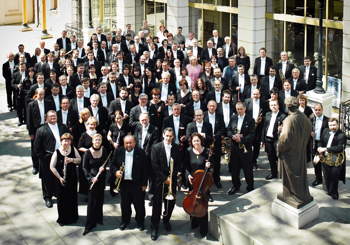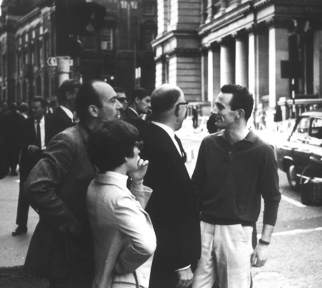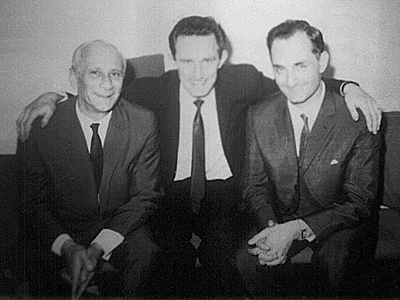
Invite them into your living room!
FREE!
| A new concept in music enjoyment: listening with the audience |
Orchestral Concert CDs is devoted to issuing recordings of live concert performances, primarily by leading Eastern European orchestras.
During the 1960s and early 1970s, Geoffrey Terry was invited to tour the UK with orchestras and ensembles from Eastern Europe. Fortunately, as a recording engineer, he was granted the opportunity to make recordings of some of the concerts for posterity. It is from those original tapes that the Virtual Concert Hall Series of CDs has been derived. More than a dozen exceptional CDs have already been published, and the range of available recordings is expected to expand in the months to come.
The recordings originate from a series of concerts given by leading European orchestras such as the Prague Symphony Orchestra, Brno Philharmonic Orchestra, Hungarian State Symphony Orchestra, Berliner Staatskapelle, Leipzig Gewandhaus Bach Orchestra and others during their tours of the UK, together with world-class ensembles, soloists and conductors.
The technical theory behind the recordings, CNSTR, is very simple: considering that the concert-goer has only two ears, just two microphones were positioned in very carefully selected locations. The balance and dynamics were left entirely in the capable hands of the musicians; in many commercial recordings, sound engineers override the conductor’s directions and constantly adjust up to 64 microphones. In the Virtual Concert Hall Series recordings, no adjustments have been made to the dynamics; nor have electronic modifications such as reverberation been added. What the listener hears is a pure acoustic mirror image of the original performance.
The warm, unmistakable atmosphere of sitting with the audience
Contact details
Orchestral Concert CDs is run by recording engineer Geoffrey Terry, who is responsible for all recordings and CD production. Should you have any queries about any aspect of the business or the CNSTR recording technique, please email him at:
Info@OCCDs.org
Queries about the Web site may be directed to the Webmaster, Richard Hallas:
Webmaster@OCCDs.org
Addresses
Please note that this site can be reached at both OrchestralConcertCDs.com and OCCDs.org. (In both cases, a www. prefix is optional.) Similarly, emails may be sent to either <Recipient>@OrchestralConcertCDs.com or <Recipient>@OCCDs.org; the two are synonymous.
About this site
This Web site was designed by Richard G. Hallas.
Printing
The pages of this site have been designed to be printable, and the pages should print out nicely in browsers that offer good CSS support for printing stylesheets. When printing, however, please ensure that you enable the printing of background images and background colours, if these are optional (as they are in Firefox). Browsers that offer good printing support include Firefox (PC/Mac), Safari (Mac/PC) and iCab (Mac).
Fonts
If present and enabled on your system, this site will use the fonts Adobe Warnock Pro and Adobe Hypatia Sans Pro.
Links
On this site, three types of link are identified within body text:
- Internal links take you to another page within this site;
- External links take you to a page on someone else’s site;
- Email links initiate sending an email in your mail software.
Hosting
 After starting out with a different hosting company, this site has spent most of its time being hosted by Just Host, and the experience of using this company has been sufficiently positive that it seemed worth joining their affiliate programme and actually recommending them here. Their prices are extremely affordable, their service is excellent and their features exceptionally generous. If you’re looking for affordable and excellent hosting, please click the (sponsored) link here to find out more.
After starting out with a different hosting company, this site has spent most of its time being hosted by Just Host, and the experience of using this company has been sufficiently positive that it seemed worth joining their affiliate programme and actually recommending them here. Their prices are extremely affordable, their service is excellent and their features exceptionally generous. If you’re looking for affordable and excellent hosting, please click the (sponsored) link here to find out more.
Resources
If you need a logo or CD image from this site for use in a review or other listing, please visit our Resources page, where you can find downloadable images of all CD covers along with other OCCDs graphics.
Background information
The Orchestral Concert CDs recordings originate from a series of concerts given by leading European orchestras during their tours of the UK in the 1960s and early 1970s. Below, there follows a personal recollection by Geoffrey Terry explaining how the recordings came to be made.
A personal recollection by Geoffrey Terry
When I was still very young, my father deserted us, leaving my poor mother with the responsibility of caring for two small boys.
I was fascinated by the violin and thus, at about the age of thirteen, was driven to commit my first and only crime. While my mother worked to feed and clothe us, I took her Singer sewing machine and exchanged it for a violin at a second hand shop in Bromley, Kent.
When she returned home and discovered my misdemeanour she was, initially, very angry, but – being a romantic by nature – couldn’t help but feel some joy from my action.
There was no money for lessons and I taught myself to play by ear, mimicking the sound I heard on the radio. After a few years I was able to play several violin concertos from memory, using my unconventional approach, and when I was 17 years old I was accepted as a member of the London Schools Symphony Orchestra, for just one season, before being obliged to undertake National Service in the Royal Air Force.
Alfredo Campoli was my idol, and I eventually met him; we became friends, and I have many original recordings of him, from his home and in live concert.
When I left the RAF, I joined the Philips Recording Studios in the West End of London, following which I worked as an audio engineer in film and TV studios.

Following my departure from the recording industry I created a hi-fi business in South London, Flying Video Service Ltd, and had a wide clientele, which included such illustrious names as Michael Jackson, George Harrison, Ringo Starr, Emmerson, Lake and Palmer, Status Quo, Led Zeppelin, Frankie Howerd, Cilla Black, David Frost and the only two who held any interest for me: Sir Colin Davis and Alfredo Campoli. I learned to fly in order to attend to customers’ needs throughout Europe.
We lived in Umbria, Italy, for ten years, then five years in the USA (where I published a trilogy of novels), followed by four years in the Czech Republic. Nostalgia compelled a return to the UK for four years, followed by a further four years in the South of France; then my Czech wife and I finally settled in the Czech Republic once more.
I operated as a concert agent, and arranged tours of the UK for the Polish Radio Symphony Orchestra, the Czech Trio, Ivan Moravec and several other artists from Eastern Europe. I also promoted the last Queen Elizabeth Hall concert for my dear friend Alfredo Campoli, at which he was accompanied by Daphne Ibbott.
How the recordings came about
At the beginning of the 1960s the formidable British pianist Peter Katin and I founded Audio Transcriptions. We made recordings of young artists appearing at the Wigmore Hall and then, with a very primitive acetate cutter, created LP records of the recitals (the technical work being my responsibility). The process was very wasteful and expensive and, with no hope of making any sort of profit, the venture was short lived.
Previously, during my time working in recording studios and film sound studios, I had become disenchanted with the methods employed by the senior engineers, and from the outset developed my own technique based on a scientific approach to the sound created by a live orchestra (see the next section, Recording a Symphony Orchestra).

Left to right: Jan Krenz and his wife,
Adolph Borsdorf and Geoffrey Terry
During the course of our relationship, Peter introduced me to the orchestral impresario Adolph Borsdorf, who arranged tours in the UK for orchestras from Eastern Europe. Adolph was anxious to have a recording made of the Northern Opera Group (Newcastle-upon-Tyne), performing La Forza del Destino and The Merry Wives of Windsor.
I made the recordings for Adolph and, having become aware of my passion for music, he invited me to join him on a journey across Eastern Europe, where he would be negotiating tours of the UK for orchestras from those imprisoned countries; I accepted very happily.
It was 1965 when we set off to drive through East Germany, Poland, Hungary and Czechoslovakia. I did most of the driving but, unfortunately, was not invited to participate in the meetings that took place. In several locations where we enjoyed concerts by the orchestras, we visited interesting places and met many of the leading musicians of the day: Karel Ančerl, Václav Neumann, Kurt Masur and many others.

Left to right: Karel Ančerl,
Geoffrey Terry and Martin Turnovský
During the course of the trip, we called on the Berliner Staatskapelle in East Berlin, the Warsaw Philharmonic, Hungarian State Symphony, Brno Philharmonic and the Prague Symphony Orchestras. All these orchestras subsequently visited the UK for tours and, once again, I was invited to accompany them. With my love of music, combined with an electronics background (particularly with regard to the recording process), I plucked up courage and asked if I might make recordings of the concerts, in the Royal Festival Hall in particular. I was both surprised and very pleased when the permission was granted.
During the late 1960s and early 1970s I accumulated a substantial library of recordings of live concerts, and have enjoyed them privately ever since. Many well-known musicians have heard my recordings and complimented me on the sound quality.
The Symphony Orchestra is something very special to me. When I hear and see an orchestra performing, I imagine the composer in the process of creating his work, and I also consider the years of study and practice employed by each of the players to achieve the wonderful, controlled sound.
Recording a Symphony Orchestra
With the natural heat generated by an orchestra, there is a current of rising air immediately above the players.
Since moving air carries sound, it is simply a question of locating the optimum position to place just two microphones above the orchestra; not forward of the orchestra, as is generally the case in what is called ‘stereo pair’ technique, as such a choice disregards the rising air phenomenon.
The first orchestral concert I recorded in the Royal Festival Hall involved the best part of a day to pinpoint the positions where the best balance and stereo image were represented. I had the advantage that I was working alone: there was no debate; it was my decision.
During rehearsal I felt that the chosen microphone positions were in fact correct. The only task that remained was to set the recording level to the maximum position on maximum sound. That having been achieved, the process during the concert was very simple. It is the task of the conductor, not the recording engineer, to control dynamics and tonal quality during a performance. Therefore, all I had to do was to start recording and sit back and enjoy the concert from my position in a commentators box at the side of the stage.
At the end of the day, listening to sections of the recorded sound, the conductor, János Ferencsik, and I were not just pleased; we were excited and delighted. More than that, we were amazed at the result.
No reverberation has been added; the ambient sound is that of the venue itself. No spot microphone was used; in the case of a soloist, that would only encourage the need to modify the balance created by the conductor: a definite no!
The only electronic modifications that I permit myself are the removal of extraneous noises, providing that can be achieved without affecting the natural sound. Certified Natural Sound Technique Recording is the description applied to the recording process described above. All CDs that I publish carry the CNSTR logo, to reassure the purchaser that the recordings were undertaken using this process.
I have used the same technique in many situations: an enlarged symphony orchestra, regular symphony orchestra, chamber orchestra, many combinations of instruments; even the organ at the Royal Festival Hall and for the purpose of recording Grand Opera. The only exception has been recordings in the home of Alfredo Campoli.
I have recorded at the Cheltenham Festival, in Rochester Cathedral, the Queen Elizabeth and Royal Festival Halls, The Albert Hall in Nottingham, Huddersfield Town Hall and the St Pancras Town Hall. I have also made recordings in halls in the Czech Republic. In each situation, and with all combinations of instruments, I utilised the same technique and achieved what I consider to be the best results possible for each situation.
Only two microphones are required because we each have only two ears, and with correct loudspeaker location on playback (not necessarily extreme left and right), the resultant recorded sound can be replicated.
The age of the recordings might suggest inferior quality, but that is not the case. The Agfa PE36 tape I chose to record on has stood the test of time, and the recordings play today as if they were recorded yesterday.
I like to refer to the CDs as being recordings of ‘Concerts’, rather than just CDs of music as such, and the list of recorded works is referred to as a ‘Programme’.
The Web site provides details of what is currently available, and all CD pages on the site utilise extracts from the recordings, featured as background music. I have also begun to add anecdotes based on my memories of the events to each of the recordings.
It may seem unlikely, but this new CD production process has succeeded in creating an absolute ‘Audio Mirror Image’ of the original concerts.
Recent reviews can be found on the Reviews page.


